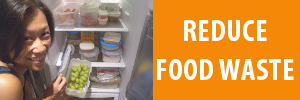ITE’s Culinary Students Develop Recipes For Unconsumed Food At Home [Press Release]
October 24, 2016 by Save Food Cut Waste
Filed under Blog
Homemakers can turn unconsumed food into a new dish instead of throwing them away
Singapore, 17 Oct 2016 – Zero Waste SG and ITE College West are co-organising the inaugural “Save Food Cut Waste” Recipes Competition 2016 for ITE’s culinary students to develop recipes for unconsumed food at home. Sheng Siong is the Food Sponsor and the National Environment Agency (NEA) is the Supporting Partner for this competition.
Families who prepare and cook food at home often have unconsumed food after their meals and end up throwing them away. A survey conducted by NEA last year found that 80% of participants prepare food at home, and 39% of those who prepare food at home have unconsumed food after a meal.
Therefore, the objective of this competition is to develop suitable recipes to help homemakers learn and cook their unconsumed food into another dish the next day, instead of throwing them away. More importantly, this competition would educate the culinary students about the problem of food waste and to be mindful about not wasting food when they are working in the food and beverage industry in the future. Read more
Food waste recycling trial at hawker centres and markets
January 23, 2016 by Save Food Cut Waste
Filed under Blog
A two-year on-site food waste recycling trial at Ang Mo Kio Blk 628 Market and Tiong Bahru Market was launched by the National Environment Agency (NEA) on Thursday, to test the economic viability and operational feasibility of two different types of on-site food waste recycling systems. The systems are leased by NEA from two vendors – Eco Wiz (SG) and VRM Operations (Singapore), and the vendors would also be in-charge of maintaining the systems. The pilot trial is expected to conclude in Dec 2017.
Zero Waste SG visited the 2 trial markets for the launch, which include both hawker centres and wet markets. Ang Mo Kio Blk 628 Market (with 218 stalls) generates about two tonnes of food waste per day, while Tiong Bahru Market (with 342 stalls) generates about three tonnes of food waste per day. Most of the food waste are generated from market slab stalls and table cleaning operations. The food waste recycling systems could reduce up to 80% of the total waste generated from both locations. Read more
Saving Money The Biggest Motivation For Households To Reduce Food Wastage: NEA & AVA Survey [Press Release]
November 23, 2015 by Save Food Cut Waste
Filed under Blog
Singapore, 20 November 2015 – A survey commissioned by the National Environment Agency (NEA) and Agri-Food & Veterinary Authority of Singapore (AVA) has revealed that saving money is the biggest motivation that will drive Singapore consumers to reduce food wastage, while concern for the environment came a close second.
2 The survey was commissioned in September 2014 to better understand the main reasons behind food wastage in households and identify triggers for change. After the survey was conducted, a focus group discussion was also carried out in July 2015, to gain further insights into the underlying perceptions, attitudes and habits of Singapore consumers with regard to food wastage. Read more
NEA to launch campaign to get people to cut food waste [News]
November 21, 2015 by Save Food Cut Waste
Filed under Blog
By Loke Kok Fai, Channel NewsAsia, 20 Nov 2015
The National Environment Agency (NEA) is launching a campaign next week to get people to cut food waste.
This comes on the back of a study by NEA and the Agri-Food and Veterinary Authority of Singapore (AVA) which showed that many people in Singapore are not comfortable with wasting food. However, the study also found that the biggest reason Singaporeans choose to cut down food waste is not to save the environment, but the pocket.
In 2014, consumers threw away 687,200 tonnes of food.
According to the study, eight in 10 respondents felt bothered about throwing away uneaten food, while 90 per cent of them felt that it was a waste of money. Concern for the environment “came a close second”, said NEA and AVA.
Click here to read the full article
Source: Channel NewsAsia
NEA calls for tender for collecting, transporting food waste [News]
August 25, 2015 by Save Food Cut Waste
Filed under Blog
By Channel NewsAsia, 24 Aug 2015
The National Environment Agency (NEA) on Monday (Aug 24) called a tender to collect and transport food waste to a facility for treatment, as part of a pilot project.
The appointed organisations will collect segregated food waste from areas such as the Clementi region and send it to a facility at Ulu Pandan Water Reclamation Plant. The places where food waste will be collected from include Ngee Ann Polytechnic, National University of Singapore, Pasir Panjang Wholesale Centre and Kranji Camp, said NEA.
Click here to read the full article
Source: Channel NewsAsia
Tender For On-Site Food Waste Management Pilot At Hawker Centres Called [Press Release]
May 22, 2015 by Save Food Cut Waste
Filed under Blog
18 May 2015 – The National Environment Agency (NEA) today called a tender for a two-year on-site food waste management pilot to be run at Tiong Bahru Market and Ang Mo Kio Block 628 Market. The pilot aims to test the economic viability and operational feasibility of food waste segregation and recycling in hawker centres, as part of government’s effort to move towards being a zero-waste nation.
2 The winning bidder(s) will be required to provide the leasing and maintenance of two on-site food waste recycling machines, which will convert segregated food waste and leftover food from the hawker stalls to either water or compost. The machines are expected to reduce the volume of food waste by at least 90 per cent per day. Read more
Amount of food waste in Singapore hits record high [News]
July 2, 2013 by Save Food Cut Waste
Filed under Blog
By Walter Sim, The Straits Times, 1 Jul 2013.
From the factory right down to the dining table, more food is being dumped in Singapore.
A new record was set for food wastage last year as 703,200 tonnes were generated – a 26 per cent spike from the 558,900 tonnes produced in 2007.
This far outpaced the 15.8 per cent growth in the local population over the same period.
The National Environment Agency (NEA) said that besides population growth, a rise in tourist arrivals and increasing affluence had contributed to the problem.
Mr Jose Raymond, executive director of the Singapore Environment Council, said the “ease of accessibility to food and increased food variety” could also have worsened the wastage.
The problem has permeated every link of the supply chain. In a statement to The Straits Times, the NEA noted that food wastage “is being produced in homes, as well as food manufacturing and catering industries, foodcourts, restaurants, supermarkets and hawker centres”.
But the amount of food being recycled each year remains low.
Click here to read the full article.
Source: The Straits Times
Why waste so much if we love food? [News]
July 1, 2013 by Save Food Cut Waste
Filed under Blog
By Tom Benner, The Straits Times, 24 Mar 2013.
Singaporeans tossed out some 675 million kilos of food in 2011, according to the National Environment Agency, a vast amount that exposes the casual attitudes and habits of living in a food paradise and land of plenty.
This may seem surprising for Singapore, a small island that imports most of what is consumed. Singaporeans are second to none in their love of food, yet one routinely sees unfinished plates getting scraped into rubbish bins, from hawker centres to high-end restaurants and catered affairs.
It is not just a Singapore problem; it is a part of a global problem of growing proportions.
Food loss and food waste occur at alarming rates – about one-third of all the food produced for human consumption, some 1.3 billion tonnes of food worth around US$1 trillion (S$1.25 trillion) – is lost or wasted each year. At the same time, world food demand grows; about one billion people are undernourished globally.
Food loss typically happens in the way food is harvested, transported, processed and stored. One example: Staggering amounts of rice are lost to substandard farm storage facilities vulnerable to pest infestation and moisture.
Click here to read the full article.
Source: The Straits Times









